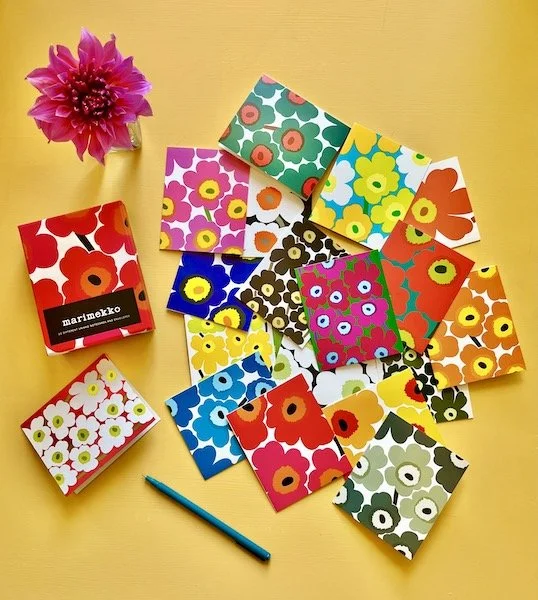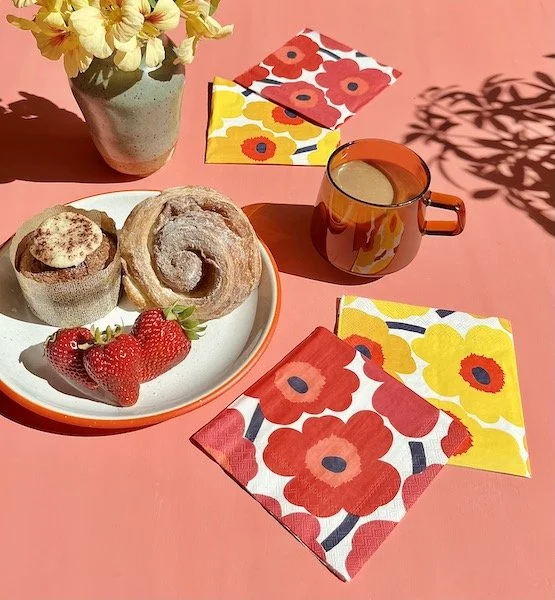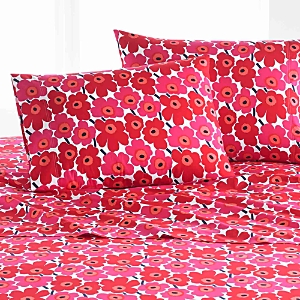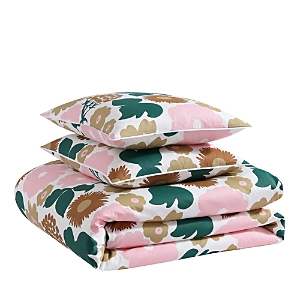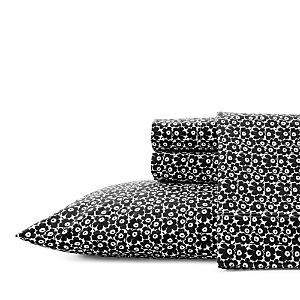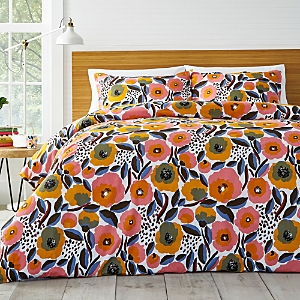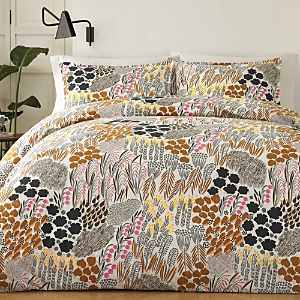Marimekko’s Unikko Flowers: How Maija Isola Created the First Superbloom in Print Design
ICONIC BLOOMS
Designed in 1964 for Marimekko, Maija Isola’s Unikko motif has become a beloved floral print around the globe – and her iconic flower pattern might just be the first two-dimensional superbloom in print design.
Under Marimekko Umbrella by Tony Vaccaro, courtesy of Tony Vaccaro Archives / Monroe Gallery of Photography
Known for its lively, brilliantly-hued floral motifs, Marimekko is a brand born from a Finnish design house focused on harmony, color, positivity, and natural beauty. With botanical patterns that reflect the rich flora in Nordic landscapes, Marimekko’s design philosophy celebrates nature's diversity by capturing the essence of Finland's gardens and forests. From vibrant tulips and delicate peonies to richly layered branches and fluttering leaves, the patterns featured on its clothing and homeware designs integrate art into daily life, happily blurring the lines of decorative design and fine art.
Unikko-print Marimekko dress, 2015
This year, Marimekko is celebrating the 60th anniversary of Unikko, its iconic floral pattern. Over the decades since its launch, cheerful Unikko blooms have appeared in innumerable color combinations, brightening everything from clothing and linens to kitchenware and rain boots. The pattern is so beloved and wide-ranging in its versatility that it’s often synonymous with the spirit of the Marimekko brand itself, which has a mission to “bring color and joy into lives and homes everywhere and encourage people to be happy as they are.”
Unikko by Maija Isola, courtesy of Marimekko
When the company debuted in 1951, Marimekko presented patterns infused with natural forms that gave the world a new way of seeing design, just as post-war Europe was craving joy, optimism, and a new identity. The woman behind the ubiquitous Unikko motif was equally as spirited and fascinating. Introduced in 1964 at the same time that the pop-art movement was at its peak, the Unikko pattern was created by fabric designer and painter Majia Isola, a visionary artist whose creativity has forever influenced the world of design.
Maija Isola painting, courtesy of Marimekko
Born in 1927 in Finland, Isola’s artistic journey first intertwined with Marimekko in 1949 when she joined Printex, the company’s predecessor, as a textile designer who’d just finished art school. When Printex evolved into Marimekko, she became its first textile designer at the age of 22. Her unique style was characterized by bold geometric patterns and vibrant colors, infusing a bright-eyed expression into the brand and helping to establish Marimekko as an icon in modern design. In a primarily gray post-war Finland, the brand’s airy, exuberant approach to patterns, color, and silhouettes was a breath of fresh air for people craving a new, more hopeful future.
Kukkatori by Maija Isola, courtesy of Marimekko
Marimekko as a business entity was also revolutionary at the time, as it was led from the beginning primarily by women – ones who had equity in the organization, travelled the globe, and built the company themselves from the 1950s onward. From the beginning, the brand’s experimental approach was also vanguard for a textile company, as it treated each design like the work of art that it was, with individual creators named on each of its fabrics.
Photograph of the recently opened Marimekko Boutique in Finland with Armi Ratia and Vuokko Nurmesniemi - unknown author, public domain, via Wikimedia Commons
As the originator of more than 500 of Marimekko’s patterns, Isola was instrumental in building the company’s design aesthetic. Influenced by the natural forms of both the Finnish landscape and the varying environments that she explored in her global travels, Isola's artistic process was as unique as her creations.
Known for her meticulous attention to detail, she immersed herself in extensive research, exploring various techniques and experimenting with real plants to push the boundaries of textile design. Her approach was perfectly suited to the nascent company, as it also sought to connect to people’s lives in a way that was less about traditional consumer goods and more aligned with a lifestyle and way of thinking – one that reflected the social currents and utopian ideals of a society reimagining itself.
Mehilainen by Maija Isola, courtesy of Marimekko
In 1964, Isola created the Unikko pattern at the height of the pop art movement, drawing inspiration from modern visual art, folk art, and her contemporaries in the world of graphic design, silkscreening, and color-field painting, including Frank Stella and Ellsworth Kelly. (Worth noting is that Andy Warhol’s first iteration of his ubiquitous Flowers series also appeared in 1964, with subsequent riffs on color combinations in 1970, though his blooms were silk-screened appropriations of an image of hibiscus flowers in Barbados by nature photographer Patricia Caulfield.)
Unikko full-length repeat by Maija Isola, courtesy of Marimekko
Free spirited and unmistakably cheerful, Unikko came to represent a vision for the company, though not without some initial consternation. As the tale goes, Marimekko founder Armi Ratia had originally forbidden any floral-printed designs to be created at the company, believing that flowers were so beautiful and unique that they wouldn’t be able to be represented well in patterns. Isola responded by creating a series of innovative botanical motifs that included the brightly colored Unikko pattern, using abstractions of hand-painted flower shapes in an endless repeat of bright blooms.
A variation on Unikko by Maija Isola for a collaboration with Adidas, courtesy of Marimekko
By rebelling with a pattern of flowers with varying sizes and angles, Isola may have even created the first two-dimensional superbloom, as Unikko didn’t adhere to any of the conventional, restrained botanical patterns that had long been in fashion. Its oversized graphics and asymmetrical repeats were worlds away from the more traditional florals of the time, which were usually small-scale muted motifs that were traditionally more fussy and conservative.
In contrast, the blooms in the Unikko pattern dance on whatever surface they adorn, not unlike a superbloom of flowers swaying in the breeze, varying in shape and size but together creating a bright, carefree burst of joy. And while it was cutting edge for the era, Unikko has also stood the test of time: the pattern has been continuously printed since its launch, a testament to its enduring appeal.
Pertti Jenytin / Lehtikuva, public domain, via Wikimedia Commons
Often sitting cross-legged on the floor when painting and designing, Isola also explored the technique of using photograms as a source of creative inspiration for her early works. Utilized by other artists including Man Ray and Picasso, photograms involve placing objects on light-sensitive surfaces and then exposing them to sunlight, creating outlines from shadows.
Using natural materials including leaves, branches, and flowers, Isola experimented with creating patterns from the shadows that then served as templates for designs. Flowers and plants that were pressed by her young daughter for a school project also inspired different series of Isola’s designs.
“I feel as if I’ll never find the time to do even a fraction of all the things I want to do…. I had a huge floral still-life of sorts spread out wet on the floor, waiting to be rolled up… paints in yogurt pots, and newspaper everywhere, and flowers in vases on the floorboards…. Large deep-red roses, small and fragrant, curiously furry pink roses, yellow, orange and white poppies, cowslips in various shades of purple, black tulips and tiny carmine flowers whose name I don’t know.”
-Maija Isola, in a 1970 letter from Paris to her daughter Kristina
Tuuli by Maija Isola, courtesy of Marimekko
In Isola’s inventive designs, forms are often reduced to their silhouettes and simplified shapes, reflecting an uncomplicated and versatile design philosophy. Far from simplistic, however, each petal and leaf in her botanical motifs was carefully rendered, with contrasting shapes that intertwined to create expressive repeats.
The pattern featured on these curtains, called Putkinotko, was one of Isola’s photogram-derived designs. The light illuminates the shadow-outlined shapes she created with natural elements like the stalks and seedheads of the perennial herb angelica, here.
Photo by Superbloom
The proximity to nature also had a hand in the design of loosely flowing clothing throughout Isola’s compositions and for the entire Marimekko brand, which simultaneously became known for its loose-fitting garments that were intentionally made for women to live, run, jump, play, create, and dance in.
From the beginning, Marimekko’s ideals influenced its silhouettes and encouraged more active movement, making it easy to spend time outdoors and unencumbering women by removing the kinds of fussy, constricting details that had characterized women’s fashions in decades prior.
Combining style and function, their roomy dresses and minimalist smocks liberated women from girdles and allowed them to move more freely. These simple forms were also often the favorite of nature-inspired artists like Georgia O’Keefe, who preferred their utilitarian, boxy dresses with pockets that could hold any number of paint supplies or natural materials picked up along her ranch in New Mexico.
Image by Yolanda Arango, CC BY-SA 2.0, via Wikimedia Commons
While Marimekko’s dresses are now considered stylish classics, they were originally perceived as more bohemian and informal, having been created in relation to the natural spaces surrounding them and as a reflection of the company’s feminist ideals. The simplified silhouettes also provided literal space that helped preserve the integrity of the patterns on them, allowing an expanse of fabric that provided an uninterrupted look at each artist’s creation.
Ruusupuu by Maija Isola, courtesy of Marimekko
Within Isola’s world, floral motifs often tell stories, and each pattern has its own narrative and meaning. Whether it's the cheerfulness of summer blooms, stems reaching toward the sun, or a tranquil scene of winter blossoms, the patterns and color palettes in Isola’s designs create a sense of freedom and often invoke an emotional response.
In many of her botanical patterns, small details convey a human touch that celebrates spontaneity over perfection: imperfectly rendered brushstrokes, slight variations that come from hand printing, and new colors that result from unintentional overlapping edges are all happy results from experimentation.
Pioni by Maija Isola, courtesy of Marimekko
Isola’s innovative approach helped shape Marimekko's aesthetic and inspired generations of artists and designers. Her vivacious color combinations breathe life into botanical motifs that transcend the boundaries of fashion, adorning not only garments but also home furnishings and accessories, helping to establish Marimekko as one of the first true lifestyle brands.
Image by Mangan02, CC BY-SA 4.0, via Wikimedia Commons
But the impact of Isola’s prolific artwork and experimentation with her craft also transcended the utility of fabric patterns and surface design, capturing the spirit of an era. Her spontaneous, energetic motifs mirrored the changing values of a society that celebrated bold, audacious, and nature-infused aesthetics. Vivid and imaginative, much of her work was a precursor to the visuals of the flower-power era, reflecting the freedom and self-expression that defined a modern period.
Florestan by Maija Isola, courtesy of Marimekko
Today, Marimekko continues to honor IsoIa's artistic legacy. Her intricate patterns and vivid colors, born from her deep connection with nature, have provided a way of seeing the world through a joyful lens. Throughout 2024, the brand is celebrating Unikko’s anniversary with flower-laden pop-up cafes in Milan and Melbourne, light projections on museums, and limited-edition products featuring special colorways of its irresistible blooms, which have even graced the exterior of hot-air balloons, trams and trains, and even Finnair jets.
Image by Masakatsu Ukon, CC BY-SA 2.0, via Wikimedia Commons
Isola’s patterns have become a cherished part of countless wardrobes and households around the world, reminding us that even if the exact essence of a wildflower can’t be captured, bringing a creative spirit to the task of replicating them can spark worlds all their own. Her sprawling Unikko pattern has even given the term “superbloom” yet another meaning, as the endurance of its abundant flowers have indeed created a boundless, free-spirited expanse of blossoms in full bloom that continue to delight, year after year.
Piirto Unikko by Maija Isola, courtesy of Marimekko / Unikko-print Marimekko dress, 2015
Disclosure: Superbloom may earn revenue via affiliate marketing commissions for some of the products we link to—though you’ll never pay more for them because of that. We feature only items that we love and that embody the Superbloom style and ethos: a joyful spirit of celebrating natural abundance. See our full disclaimers and disclosures for more information about the affiliate programs in which we participate.
Marimekko: The Art of Printmaking (Bookshop.org or Amazon)
Marimekko Unikko Notecard Set (Bookshop.org or Amazon)
Marimekko Unikko Paper Napkins
Marimekko Unikko 60th Anniversary Paper Napkins
Our Favorite Unikko Apparel & Homewares
Marimekko Unikko Comforter Set and Unikko Sheet Set
Marimekko Pieni Kukkatori Duvet Cover Set and Pikkuinen Unikko Sheet Set
Marimekko Rosarium Comforter Set and Pieni Letto Comforter Set























